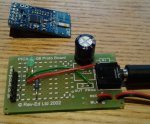Has anyone done the work to enable an erf module to connect into a Picaxe board via the download socket? It didn't work when I tried it so I expect the 22k resistor is a problem, needing some sort of signal conditioning.
It would be so much more useful to reprogram fixed installations in the house if I didn't have to hardwire an erf (or at least a new header) into them.
I will try to do it myself if noone else has, but 'on the shoulders of giants' ..
It would be so much more useful to reprogram fixed installations in the house if I didn't have to hardwire an erf (or at least a new header) into them.
I will try to do it myself if noone else has, but 'on the shoulders of giants' ..

